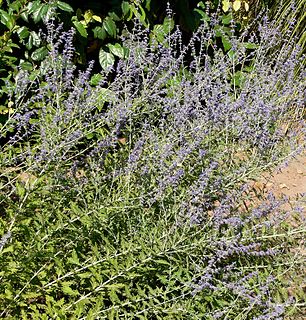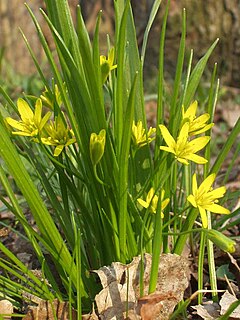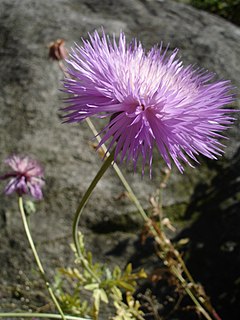
Salvia subgenus Perovskia is a group of species within the flowering plant genus Salvia, which prior 2017 were treated as the separate genus Perovskia. Members of the group are native to southwestern and central Asia. It includes the garden plant Russian sage.

Gagea is a large genus of spring flowers in the lily family. It is found primarily in Eurasia with a few species extending into North Africa and one species in North America.

Ixiolirion is a genus of flowering plants native to central and southwest Asia, first described as a genus in 1821. Recent classifications place the group in the monogeneric family Ixioliriaceae in the order Asparagales of the monocots. In earlier systems of classification, it was usually placed in the family Amaryllidaceae.

Leonurus is a genus of flowering plants in the family Lamiaceae. It is native to Europe and Asia, naturalized in New Zealand, Hawaii, New Caledonia, and much of North and South America.

Lagochilus is a genus of the mint family that contains Turkistan mint.

Haloxylon persicum, the white saxaul, is a small tree belonging to the family Amaranthaceae. Its range is Western Asia, including the Palestine region, Egypt, Sinai, South Iraq, Saudi Arabia, Iran, Oman, UAE, Afghanistan, and Pakistan, to Central Asia, and China.

Eremurus is a genus of deciduous perennial flowers in the family Asphodelaceae. They are also known as the foxtail lilies or desert candles. They are native to eastern Europe in, and temperate Asia from Turkey to China.

Eminium is a genus of flowering plants in the family Araceae. The genus ranges from Turkey and Egypt east to Central Asia. Usually they can be found growing in barren areas in sand or stony soil. The foliage of Eminium resembles Helicodiceros and its inflorescence and fruit resembles those of Biarum.
- Eminium albertii(Regel) Engl. - Turkmenistan, Uzbekistan, Afghanistan
- Eminium heterophyllum(Blume) Schott - Iran, Iraq, Turkey
- Eminium intortum(Banks & Sol.) Kuntze - Turkey, Syria
- Eminium jaegeriBogner & P.C.Boyce - Iran
- Eminium koenenianumLobin & P.C.Boyce - Turkey
- Eminium lehmannii(Bunge) Kuntze - Kazakhstan, Kyrgyzstan, Turkmenistan, Uzbekistan, Afghanistan, Tajikistan
- Eminium rauwolffii(Blume) Schott - Turkey, Syria
- Eminium regeliiVved. - Kazakhstan, Kyrgyzstan, Tajikistan, Uzbekistan
- Eminium spiculatum(Blume) Schott - Egypt, Israel, Palestine, Jordan, Lebanon, Syria, Iraq, Iran

Amberboa is a genus of flowering plants in the family Asteraceae, described as a genus in 1832.
Microcephala is a genus of Asian flowering plants in the chamomile tribe within the daisy family.
Syreitschikovia is a genus of flowering plants in the family Asteraceae.
This page shows the Kyrgyzstan national football team's results in International Matches, as recognized by FIFA:
Galeodes is a genus of solifuges or sun spiders. The nearly 200 species in this genus are found in northern Africa, southeastern Europe and Asia. Like other solifuges, they are mainly nocturnal and found in arid habitats. They often have long hairy appendages and are not as stout bodied or dark and contrastingly coloured as some other solifuges. Some Galeodes species are able to produce sounds by stridulation. These are usually raspy or hiss-like and may be imitations of the sounds of vipers, to serve a defensive function. As in other solifuges, mating involves the male depositing a spermatogonia that is manipulated into the female genital opening using their chelicera. The male strokes the female using the palps allowing her to be approached. Females will often feed on males before or after mating. The female then deposits the eggs in a burrow in soil and in some species guards them.

This page shows the Tajikistan national football team's results in International Matches, as recognized by FIFA:

Allium oreophilum, the pink lily leek, is a plant species native to Xinjiang, Afghanistan, Kazakhstan, Kyrgyzstan, Pakistan, Tajikistan, Uzbekistan, Iran, Iraq, Turkmenistan, European Russia, Turkey, Azerbaijan, Armenia and Georgia.

Ungernia is a genus of bulb-forming plants in the Amaryllis family, native to central and south-central Asia Asia.

Lophanthus is a genus of plants in the family Lamiaceae, first described in 1763. It is native to central and southwestern Asia from Turkey to Mongolia, with many of the species endemic to Iran.
- Lophanthus adenocladus(Bornm.) Levin - Iran
- Lophanthus allotrius(Rech.f.) A.L.Budantzev - Iran
- Lophanthus archibaldii(Rech.f.) A.L.Budantzev - Iran
- Lophanthus chinensisBenth. - Mongolia, Xinjiang, Siberia
- Lophanthus depauperatus(Benth.) Levin - Iran
- Lophanthus dschuparensis(Bornm.) Levin - Iran
- Lophanthus elegans(Lipsky) Levin - Afghanistan, Tajikistan
- Lophanthus hedgei(Freitag) A.L.Budantzev - Afghanistan
- Lophanthus iranshahrii(Rech.f.) A.L.Budantzev - Iran
- Lophanthus kryloviiLipsky - Mongolia, Xinjiang, Kazakhstan, Altai
- Lophanthus laxiflorus(Benth.) Levin - Iran
- Lophanthus michauxii(Briq.) Levin - Iran
- Lophanthus ouroumitanensis(Franch.) Kochk. & Zuckerw. - Afghanistan, Tajikistan
- Lophanthus oxyodontus(Boiss.) Levin - Iran
- Lophanthus pinetorum(Aitch. & Hemsl.) Levin - Afghanistan, Pakistan, western Himalayas
- Lophanthus schrenkiiLevin - Xinjiang, Kazakhstan, Kyrgyzstan
- Lophanthus schtschurowskianus(Regel) Lipsky - Kyrgyzstan, Tajikistan
- Lophanthus sessilifolius(Bunge) Levin - Iran, Pakistan
- Lophanthus subnivalisLipsky - Kyrgyzstan, Tajikistan
- Lophanthus tibeticusC.Y.Wu & Y.C.Huang - Tibet
- Lophanthus tschimganicusLipsky - Kyrgyzstan, Uzbekistan
- Lophanthus turcicusDirmenci, Yıldız & Hedge - Turkey
- Lophanthus varzobicusKochk. - Tajikistan

Askellia is a genus of Asian and North American plants in the tribe Cichorieae within the family Asteraceae.
Garhadiolus is a genus of Asian plants in the tribe Cichorieae within the family Asteraceae.

The taxonomy of Tulipa places the genus in the family Liliaceae, and subdivides it as four subgenera, and comprises about 75 species.















